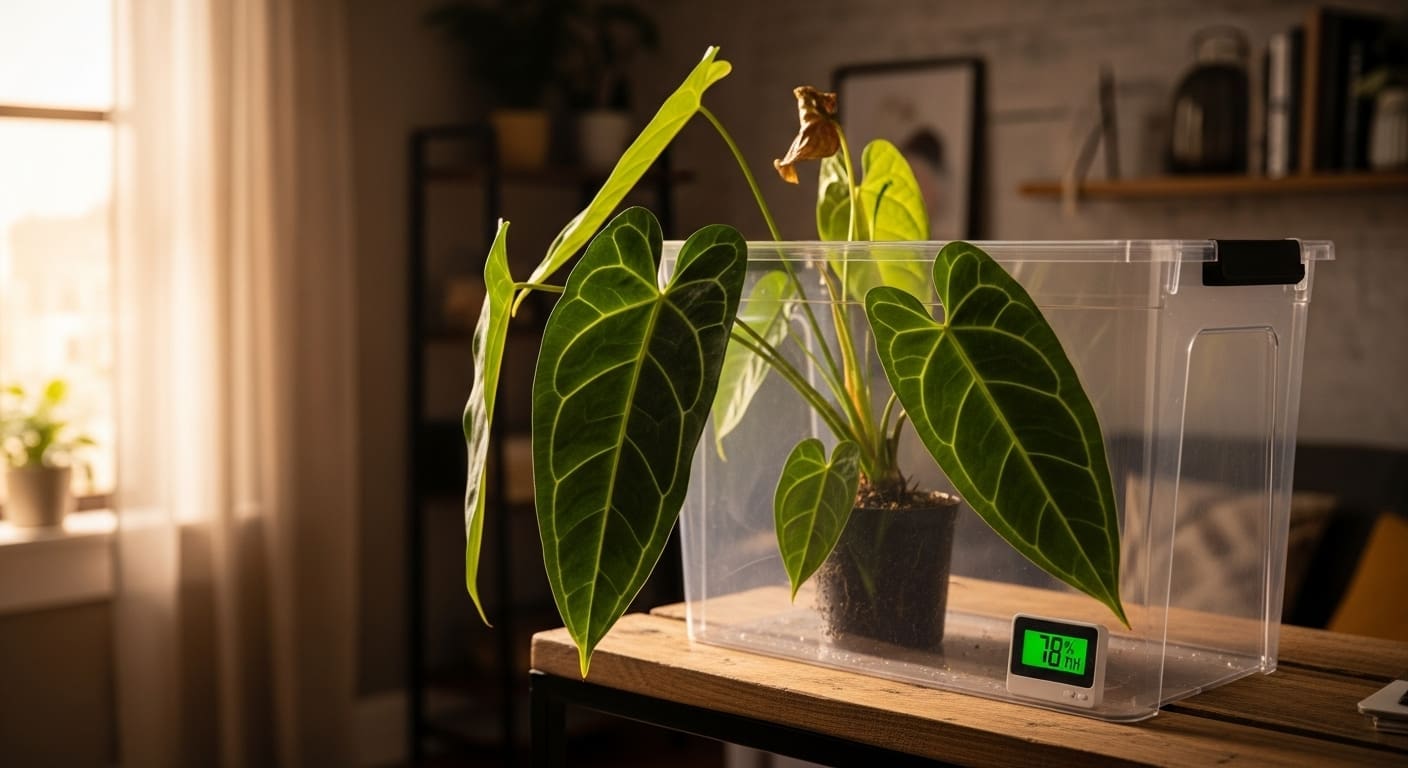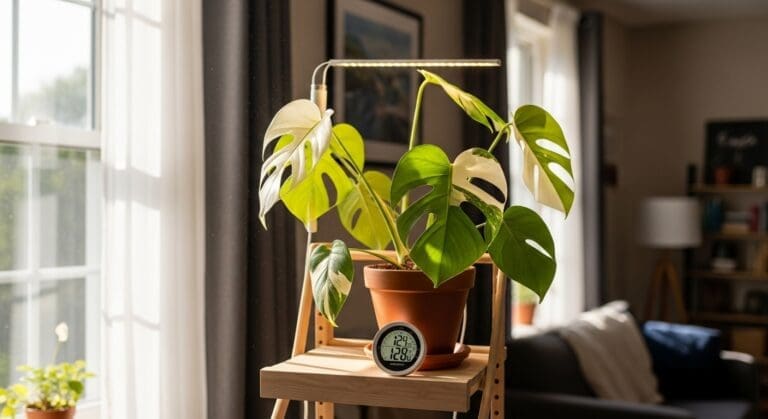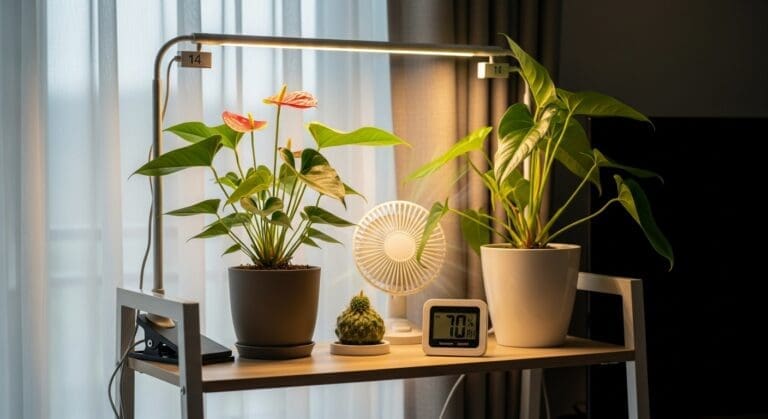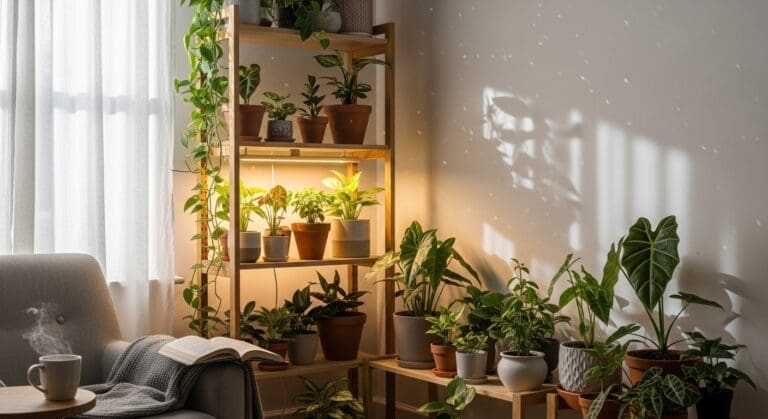An imported Queen Anthurium can look like a crumpled velvet flag—beautiful, shocked, and begging for a soft landing. The first day decides everything. Handle that window, warmth, and water well, and the plant almost exhales.
“Last time I opened a box at 8pm and promised myself I wouldn’t fuss. I made tea, set a timer, and just followed the checklist.”
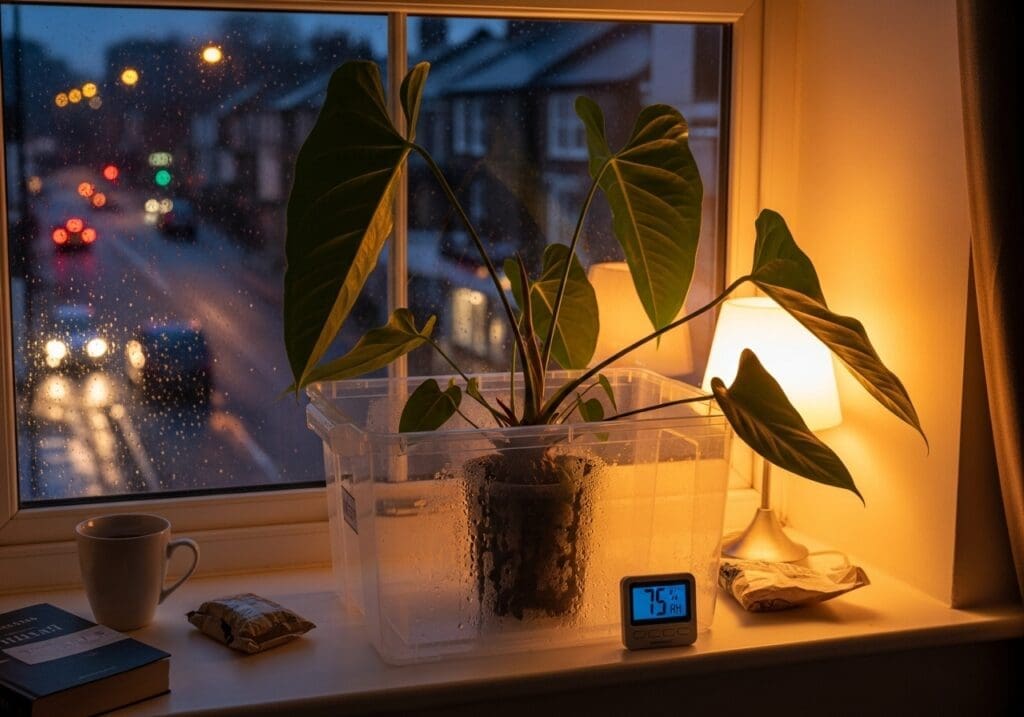
Quick answer: the 24-hour goal
Keep the plant warm (68–75°F / 20–24°C), humid (70–85% RH), and bright but not intense for one day while you assess roots and pests. Avoid repotting unless the media is rotting or sopping wet. Place it in a stable microclimate—a clear bin, IKEA cabinet, or small greenhouse shelf—with a gentle fan outside the bin for air movement in the room, not blasting the plant.
Will it look worse before it looks better? Sometimes, yes. The aim today is stability, not perfection.
Background & definitions that actually help
Acclimation simply means helping a plant adjust from one environment to another. Imports go from tropical farms → freight → customs → your living room. That’s a rollercoaster.
PPFD (photosynthetic photon flux density) is the light the leaf actually receives. For day-one rehab, think low-to-moderate PPFD (~80–150 µmol·m⁻²·s⁻¹)—brighter than a dark corner, gentler than a grow-light spotlight.
DLI (daily light integral) is total light over the day. For the first 48–72 hours, you want a modest DLI, which you’ll naturally get by keeping the plant a little further from lights and avoiding midday sun.
24-hour rehab checklist (what to do, in order)
- Unbox calmly (0–15 min). Photograph the plant, the roots, and any damage. You’ll thank yourself later if a leaf declines and you need a baseline.
- Dry wipe, don’t soak (10 min). Gently wipe leaves with a barely damp microfiber cloth. Skip heavy sprays tonight—stressed foliage doesn’t need extra moisture on the blades.
- Root check (15–20 min). If it’s bare-root: trim only obviously mushy roots. If it arrived in moss, open the wrap and loosely re-nestle the roots; don’t compact. If the media is foul or smells sour, repot into temporary medium (chunky moss + bark), just enough to stabilize—not a forever pot.
- Quarantine & climate (10 min). Place into a clear bin, small greenhouse shelf, or IKEA cabinet. Add a tray with shallow water + pebbles (not touching the pot) to lift humidity to 70–85% RH. Keep temp 68–75°F / 20–24°C.
- Light choice (1 min). North-facing window in a London flat? Great. Bright east window in Chicago? Also fine. Under a grow bar? Start 30–45 cm / 12–18 in away to keep PPFD gentle.
- Hydration (5 min). If roots are hydrated, don’t water right away. If they’re crisp-dry, trickle 30–50 ml room-temp water around the root zone—just enough to moisten, not drench.
- Pest scan (10 min). Use a loupe to check leaf undersides and petioles. If you see thrips or mites, isolate inside the bin and follow your standard routine per label (insecticidal soap or beneficials after day 2–3).
- Leave it alone. Close the bin/cabinet. Re-check in 12 hours for humidity and condensation. No fertilizer today.
“Every time I almost repot on day one, I hear my future self whisper: please don’t. Tomorrow is always kinder.”
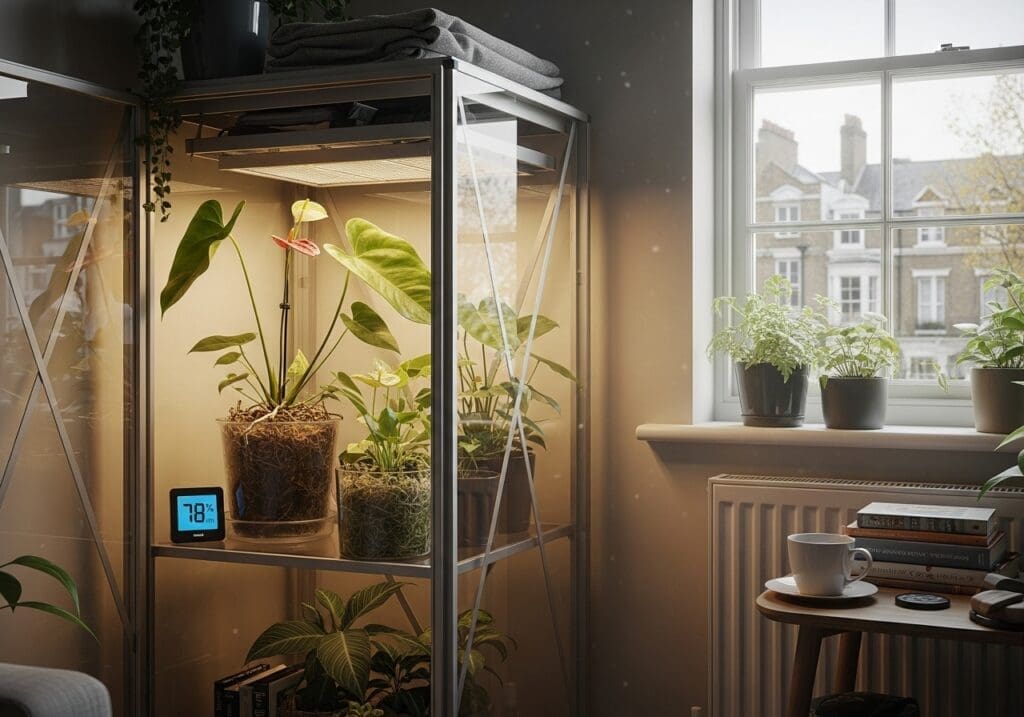
Care targets that actually work (days 1–7)
Warocqueanum leaves are velveted and thin; they bruise from extremes. Think steady, not heroic.
Light. Keep PPFD around 100–150 µmol·m⁻²·s⁻¹ for days 1–3, then nudge a grow bar closer across a week. If you’re using a 20–40 W bar, starting 12–18 in (30–45 cm) away works in most apartments.
Humidity. Aim 70–85% RH inside the bin/cabinet; vent 5–10 minutes/day to refresh air. In centrally heated US homes or drafty UK flats, the bin is your friend.
Temperature. 68–75°F / 20–24°C keeps metabolism ticking without stressing soft tissue. Avoid hot radiators and wintery sash-window drafts.
Water. Keep media slightly moist, never wet. If in loose moss + bark, water with a syringe or small cup along the edges. If you see condensation raining inside the bin, air it for a few minutes.
Feeding. None in the first week. Start at ¼ strength after new root tips appear.
Potting mix. For future pot-up, use a chunky aroid mix—bark, perlite, a bit of sphagnum, and a pinch of charcoal. I model mine on our aroid soil mix so the roots get air, not soup.

If X → try Y (common day-one signals)
Leaf curl + dull sheen? Likely dehydration plus shipping shock. Keep RH high, give a sip if roots are dry, and reduce light.
Translucent patches? That’s physical damage or cold stress. Stabilize conditions; don’t cut unless it spreads.
Black root tips? Trim to healthy tissue and re-nestle in airy medium. Keep slightly moist and warm.
Tiny silver streaks? Suspect thrips. Bin quarantine stays closed; treat per label on day 2–3.
Common mistakes & fixes (fast wins)
- Over-lighting on day one. Start gentle; raise intensity after 72 hours.
- Heavy watering into tight moss. Loosen fibers; water minimally.
- Immediate full repot. Unless it’s rotten, wait until the plant stabilizes.
- No quarantine. Always isolate imports; it protects the whole collection.
- Spraying oils in a closed bin. Treat outside the bin with good airflow and follow labels.
What I actually do in my apartment
I set the cabinet to 74°F / 23°C, keep RH ~78%, and park the grow bar 15 in / 38 cm above the crown for three days. I water 30–40 ml at a time, every 3–4 days, only when the moss feels springy, not squishy.
Expert insight
As one curator put it succinctly, “Imported aroids bounce back fastest when you give them stable warmth, modest light, and time—repotting can wait.” That patient approach echoes guidance from the Royal Horticultural Society, which emphasizes steady conditions and careful watering for stressed indoor plants.
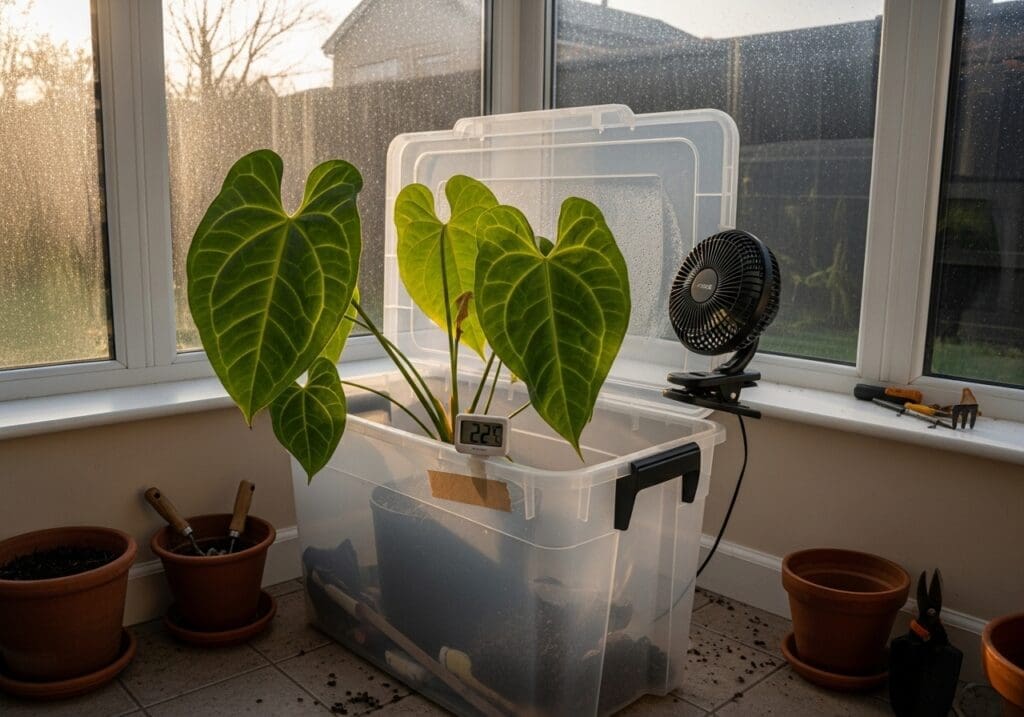
FAQs
How long should the acclimation last after import?
Plan for 1–2 weeks of gentle conditions. You can start increasing light after day 3 if the leaves stay firm and new root nubs appear.
Should I cut damaged leaves right away?
Not on day one. Damaged blades still photosynthesize and help recovery. Trim only if rot spreads.
When can I repot into a permanent aroid mix?
When you see active white root tips and steady hydration—often week 2–4. Then move to a chunky mix like in our aroid soil mix and check our grow light distance guide to avoid leaf scorch.
Seasonal tweaks for US & UK homes
Winter brings radiator dryness in New York and drafty sash windows in London. Keep the bin closed more of the day, and consider a small heat mat with a thermostat if your space dips below 66°F / 19°C. Summer sun in south-facing windows can spike PPFD; pull the plant back 6–8 in (15–20 cm) or diffuse with sheer curtains.
Wondering if the Queen is “worth it” after that long flight? Or if it will ever unfurl a leaf like the photos? Those questions are normal—stability now makes the magic later.
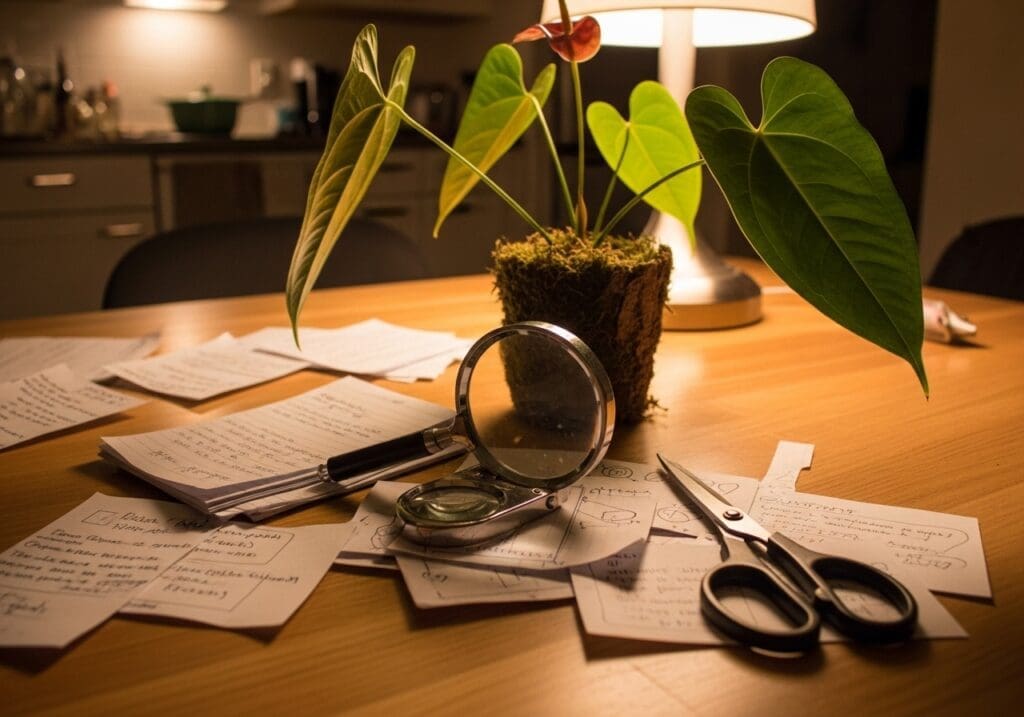
You don’t need a greenhouse empire—just a calm first day, a clear bin, and a little restraint. The Queen forgives a lot when the 24-hour rehab is quiet and consistent.
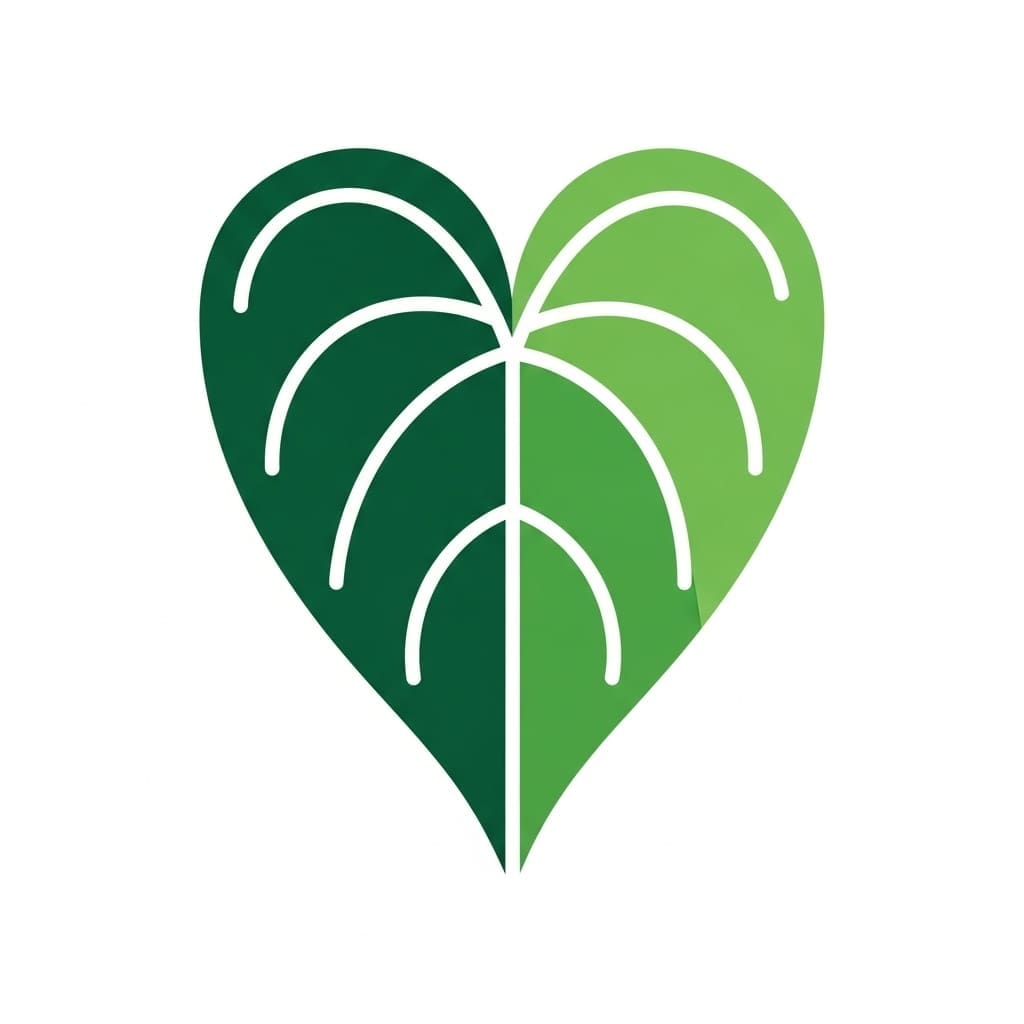
RarePlantCare Editorial Team produces expert content on rare plants.
Our articles are AI-assisted and human-edited before publication.
We aim to provide practical, evidence-based guides for plant lovers worldwide.
Learn more about our Editorial Policy


